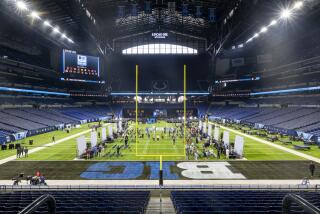Coalition Goal Is Athletes’ Rights
When the Collegiate Athletes Coalition announced its formation in January 2001, I had no idea it would establish itself so quickly. As for the chairman of this group of current and recently graduated athletes, he had no idea the cause could be so ... cold.
With the coalition nearing its second year of existence, about 30 members were in Columbus, Ohio, last weekend to hand informative fliers to fans on their way in to the Michigan-Ohio State football game.
“It was freezing, man,” said CAC chairman Ramogi Huma, a former UCLA linebacker. “But I managed to hand out fliers” -- an estimated 70,000 of them. Listed were the group’s concerns that health insurance doesn’t cover summer “voluntary” workouts, that athletes can have their scholarships revoked when they are injured, and that when players die -- as three college football players did last year -- the NCAA’s death benefit is often inadequate for the funeral costs. In part, the flier said, “The players that you are watching today are at risk.”
Most people stuffed the fliers in their pockets. Some stopped to ask questions. A few had even heard of the group and were happy to see members on campus.
What recognition the group has came from a story on “60 Minutes” in January and a trip to Capitol Hill to speak to Congress last summer. Not bad for an organization that was just a concept 2 1/2 years ago.
“We’re getting there,” Huma said. “We’re getting to somewhat of a critical mass where we can pressure the NCAA.”
But the NCAA likes to operate its own agenda, in its own time. Huma did have some correspondence with former NCAA president Cedric Dempsey, but Dempsey canceled an arranged meeting at January’s NCAA convention. Huma sent a letter to the NCAA’s management council, Division I board of directors and President-elect Myles Brand in October and hasn’t heard back.
When I called the NCAA on Monday to ask if anyone cared to respond to the letter, a spokeswoman said it would require further research.
With more than 1,000 member schools and a voluminous book of regulations, the NCAA winds through a long, laborious process with just about everything. Huma wonders just whom those rules and regulations serve, because it doesn’t seem to be the athletes anymore.
“There are inherent risks in sports,” Huma said. “We’re looking to minimize those risks. That’s what they [the NCAA] were founded on. They’re getting so far away from it.”
For Huma, the turning point came six years ago when his teammate, Donnie Edwards, was suspended for accepting a bag of groceries from a sports agent. Edwards claimed he didn’t know the food was from an agent.
“You have to choose between not honoring NCAA rules or eating?” Huma said. “We wanted to support Donnie, but what could we do? That was the inspiration for the whole movement.”
It took a while to get going. When it started coming together in the summer of 2000, Huma began sending e-mails to labor organizations seeking help. One of them landed in the inbox of Tim Waters at the United Steelworkers of America.
He took it to his president, Leo Gerard. Then they ran it by the lawyers.
“We wanted to make sure that if we helped them that we stay within the NCAA’s guidelines,” Waters said. “We wanted to make sure we didn’t put any players at risk.
“This is something that we should be involved in. Health insurance, fairness, death benefits are generally in the area of things our organization fights for every day.”
Don’t be fooled by the union’s title. It isn’t limited to steelworkers -- or even Americans.
“Under 15% of our membership is in the steelworkers,” Waters said. “We represent everything from nurses to all the workers at the University of Toronto.
“Our union is a mixture of a lot of other unions. People think of big mills, but our biggest single employer today is Goodyear Tire and Rubber.”
Technically, the CAC can’t be a union because the athletes are not university employees. There can be no arbitration or collective bargaining.
“This [the CAC] is one of the most interesting,” Waters said. “But the issues draw us closer to it. In our opinion, [the NCAA] is a corporation -- they call themselves nonprofit -- that has a group of people making billions of dollars, and they’re not looking out for the concerns and the best interests of the people generating all this money. It smacks of unfairness by an employer.”
With the organizational and financial support of United Steelworkers, the CAC has a foothold on 15 campuses, including every school in the Pacific 10 Conference. One notable exception is the football program at Arizona.
When Huma and Ryan Roques, another former UCLA player, went to meet with Coach John Mackovic, he quickly dismissed them and told them he wasn’t the guy they were looking for.
“That was a stark contrast from the response we get from other coaches,” Huma said. “Most coaches want anything they can get for their players.”
So he wasn’t surprised a couple of weeks ago when more than 40 Arizona football players went to the school president to ask that Mackovic be removed.
“For half the team to come together, that means things must have been really bad,” Huma said.
But Mackovic stayed. As is usually the case, the players’ wishes were not heard.
That’s why Huma and his organization keep at it. They feel they’ve taken steps, such as the NCAA’s willingness to consider lifting the $2,000 limit on athletes’ out-of-season work earnings.
“It hasn’t been easy,” Huma said. “What really drives it is the players want something like this. That’s the reason we’re still here.
“We’re not a here-today, gone-tomorrow group. We’ve been here almost two years now. We plan on being a permanent fixture in college sports.”
*
J.A. Adande can be reached at [email protected].
More to Read
Go beyond the scoreboard
Get the latest on L.A.'s teams in the daily Sports Report newsletter.
You may occasionally receive promotional content from the Los Angeles Times.










